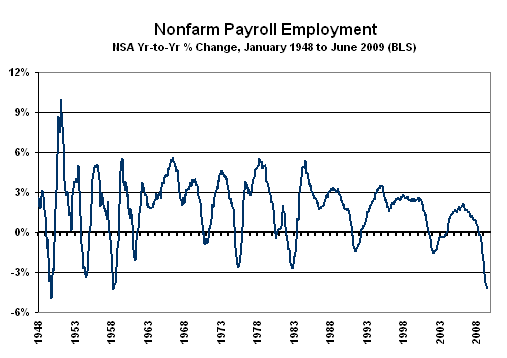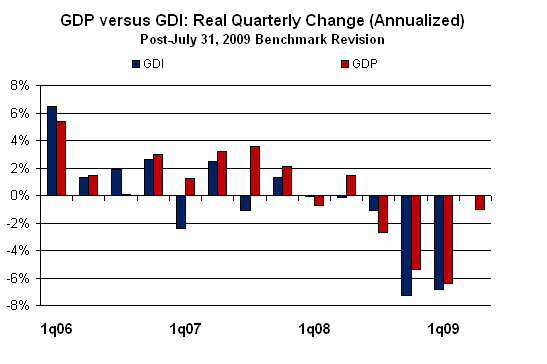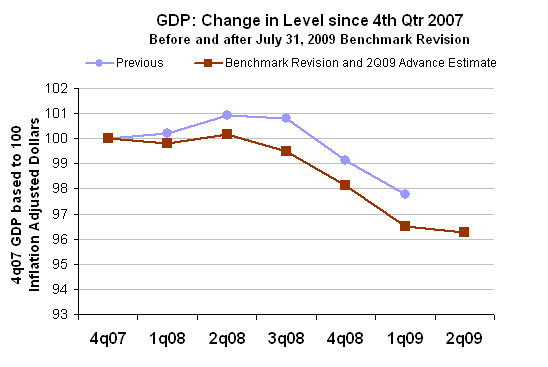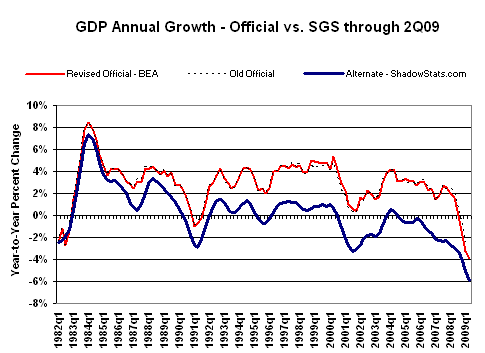Results 1 to 2 of 2
Thread Information
Users Browsing this Thread
There are currently 1 users browsing this thread. (0 members and 1 guests)
-
09-14-2009, 09:38 AM #1Senior Member


- Join Date
- May 2007
- Location
- South West Florida (Behind friendly lines but still in Occupied Territory)
- Posts
- 117,696
Current Economic Downturn Is Worst Since Great Depression
this is a pay web site thats too rich for my blood. They release old news 45 days after release... but it is still relevant
Government Shadow Statistics
DEPRESSION SPECIAL REPORT
Number 52
August 1, 2009
Current Economic Downturn Is Worst Since Great Depression
Recession Started a Year Earlier Than Official Reckoning
Business Contraction Triggered Systemic Solvency Crisis; Not the Other Way Around
Still Heavily Gimmicked, Post-Revision GDP Shows More Realistic Numbers
Economic Crisis Is Far from Over
OVERVIEW
U.S. Economy Is in a Multiple-Dip Depression. The grand benchmark revision of the national income accounts on July 31, 2009 confirmed that the U.S. economy is in its worst economic contraction since the first downleg of the Great Depression, which was a double-dip depression. The current economic downturn increasingly will be referred to as a depression, and it is far from over. There will be intermittent blips of new activity, such as the current cash-for-clunkers automobile giveaway program that appears to be generating a one-time spike in auto sales. Yet, this downturn will continue to deteriorate, proving to be extremely protracted, extremely deep and particularly nonresponsive to traditional stimuli.
As discussed in recent writings, the economy suffers from underlying structural problems tied to consumer income, where households cannot keep up with inflation and no longer can rely on excessive debt expansion for meeting short-falls in maintaining living standards. The structural issues are not being addressed meaningfully and cannot be addressed without a significant shift in government economic and trade policies, which under the best of circumstances still would drag out economic woes for many years.
The current depression likely will show multiple dips in business activity, as was seen during the Great Depression and in the double-dip recession of the early-1980s. I shall argue that the current downturn started at least a year earlier than the December 2007 onset proclaimed by the National Bureau of Economic Research (NBER), official arbiter of U.S. recessions. The current depression is the second dip in a multiple-dip downturn that started back in 1999, and it preceded and in fact was the proximal trigger for the systemic solvency crisis that rose to public view in August 2007. The ensuing systemic problems did not cause the slowdown in business activity, but they exacerbated it significantly.
While the current circumstance should become recognized as a "depression," worse lies ahead as the U.S. governmentâs long-range insolvency and current efforts at debasing the U.S. dollar trigger a hyperinflation in the next five years. Risks for the onset of a hyperinflation in the United States are particularly high during the next year. As will be discussed in the soon-to-be-updated Hyperinflation Special Report (see the existing April 2008 version for basic background), the United States would be particularly hard hit by such a circumstance. Unlike Zimbabwe, which has been able to maintain some level of functioning commerce during its hyperinflation, due to the backstop of an active black market in U.S. dollars, the United States has no such backstop. Accordingly, a U.S. hyperinflation likely would force cessation of regular commerce, triggering a great depression of a magnitude never before seen in the United States.
So as to simplify the language in this Special Report, here are definitions of key terms used:
- "Real" means growth or dollar amounts have been adjusted for inflation.
- "Nominal" means growth or dollar amounts have not been adjusted for inflation. For example, this is the way a business normally records its revenues.
- "Quarterly growth," unless otherwise stated, is in terms of seasonally-adjusted, annualized quarter-to-quarter growth, i.e., the growth rate of one quarter over the prior quarter, raised to the fourth power.
- "Annual growth" refers to the year-to-year change versus the same period the year before.
- "Depression" is a recession where peak-to-trough decline in real economic activity exceeds 10%.
- "Great depression" is a depression where peak-to-trough decline in real economic activity exceeds 25%.
Economic Downturn Preceded the Systemic Solvency Crisis. The graphs that follow show the revised year-to-year real in change gross domestic product (GDP) from the inception of the quarterly GDP series (1947 for level, 1948 for year-to-year change) to date, along with plots for the same period (1948-to-date) of annual change in industrial production, nonfarm payrolls, housing starts and retail sales.
Year-to-year change in the various series hit cycle highs and began to weaken in late-2005 for housing and durable goods orders (longer-term leading indicators), early-2006 for nonfarm payrolls (coincident indicator), late-2006 for retail sales (shorter-term indicator) and industrial production (coincident indicator), patterns more consistent with a late-2006 instead of the official late-2007 recession onset.




Gross Domestic Income Also Suggests an Earlier Recession Timing. National income accounting is akin to double-entry bookkeeping. An entry on the consumption side is reflected in gross domestic product (GDP) reporting. That is offset on the income side, reflected in gross domestic income (GDI) reporting. The GDP and GDI are theoretical equivalents, but such rarely is the case, as the two elements are estimated and surveyed separately from each other. Any differences in the reporting of GDP and GDI are offset by the addition or subtraction of a "statistical discrepancy" account on the GDI side.
The Bureau of Economic Analysis (BEA) contends that the GDP is the more accurate measure, but I would argue that the GDI, net of the discrepancy, is more accurate. The BEA concentrates its efforts on the GDP as the headline number, and whatever political machinations take place (including targeting results for consensus economic forecasts) are worked on the GDP. The GDI then is brought into line with adjustments to the statistical discrepancy.
In theory, particularly with the "improved" income measurement methodologies introduced, the statistical discrepancy should tend to disappear after a grand benchmark revision. Instead, for the last five years the "statistical discrepancy" averaged $106 billion, irrespective of sign, after the benchmark, up from $100 billion before the revisions. For second-quarter 2009, the discrepancy narrowed in revision to minus $152 billion from the prior minus $158 million.
As shown in the following graphs, annual real growth in the GDI peaked in first-quarter 2006, while the peak in GDP was in third-quarter 2007. The second-quarter 2009 GDI will not be reported until next month, given the unreliability of "advance" GDP reporting, but on a quarterly basis, the revised GDI contracted in seven out of the last nine quarters, including two quarters in 2007; the GDP contracted in four out of the last five (and nine) quarters, not including the just-released second-quarter GDP.



Revised GDP Shows Sharpest Annual Decline in History of the Quarterly GDP Series. As discussed in the Flash Update of July 31st, the benchmark revision was pretty much as expected, showing a much deeper and longer recession in place than previously had been reported. Despite ongoing gimmicks and misreporting, the GDP now more closely tracks the timing of the recessionâs official December 2007 onset, as previously proclaimed by the NBER.
As shown in the accompanying graphs, recent real annual growth rates now show a steeper pattern of slowing/contracting growth: 3q07 (near-term peak) was up 2.7% (previously up 2.8%); 4q07 was up 2.5% (previously up 2.3%);1q08 was up 2.0% (previously up 2.5%); 2q08 was up 1.6% (previously up 2.1%); 3q08 was up 0.0% (previously up 0.8%); 4q08 was down 1.9% (previously down 0.9%); 1q09 was down 3.3% (previously down 2.5%); 2q09 was down 3.9% in its "advance" estimate.
Five of the last six quarters now are reported in real quarterly contraction. The revised official real GDP quarterly growth rates (and prior estimates of growth) are: 1q08 was down 0.7% (previously up 0.9%); 2q08 was up 1.5% (previously up 2.8%); 3q08 was down 2.7% (previously down 0.5%); 4q08 was down 5.4% (previously down 6.3%); 1q09 was down 6.4% (previously down 5.5%); 2q09 was down 1.0% in its "advance" estimate.
As noted in the SGS Newsletter No. 51, July 2009 marked the 19th month of economic contraction, the longest downturn (based on NBER timing) since the first downleg of the Great Depression. The new string of quarterly GDP contractions, as well as annual declines of 3.3% and 3.9%, respectively, in first- and second-quarters 2009, are the worst showings in the history of the quarterly GDP series, which goes back to 1947/1948. There was a steeper annual real contraction in GDP (annual average series for 1946) reflecting the shutdown of war-time production following World War II, but such is not considered a normal business cycle, and it did not last as long as the current economic downturn has, already.
As discussed earlier, the better economic indicators still show the recession to be deepening. The second-quarter GDP "improvement" was only in terms of relative quarter-to-quarter growth. The quarterly real contraction was reported at 1.02% (down 5.94% net of revision) +/- 3% (95% confidence interval) versus a revised 6.43% (previously 5.49%) contraction in the first quarter.
The reported smaller contraction likely was viewed as necessary for political and financial-market hype. Keep in mind that this "advance" estimate is roughly 90% guesstimate (only two of three months of trade data are available, for example), and it is the most heavily politicized of the major economic series.
The relatively narrower quarterly contraction in the second quarter reflected the impact of greater weakness being thrown back into the first quarter, in revision, and the use of artificially reduced inflation. The implicit price deflator for the second quarter was 0.2% versus a revised 1.9% (was 2.8%) in the first quarter.
The following graphs show the results of the benchmark revisions on the level of real GDP as well as in terms of annual and quarterly real growth rates.



In other revisions, historical nominal and real GDP levels saw negligible revisions from 1929 through 1991, other than the base year for inflation was changed to 2005 from 2000 for the entire series. Starting in 1992, the nominal level of annual GDP was upped at an accelerating pace, starting at 0.1% in 1992 and peaking at 2.0% in 2007, easing back to 1.2% in 2008. This pattern likely incorporated a smoothing of revisions due to a once-in-five-year input-output survey, but a new round of Pollyanna Creep â happy biases being created with new reporting methodologies and restated for past history â may be in the works. Such will be addressed further in an updated version of the GDP Primer Series on www.shadowstats.com.
The SGS Alternative Measure of GDP Suggests 5.9% Annual Contraction. The SGS-Alternate GDP is an estimate of what the GDP would look like net of changes in reporting methodologies since the early-1980s. These changes generally have added upside reporting biases to GDP growth, biases that have moved GDP reporting up and away from common experience. (The methodology for the SGS-Alternate GDP series was discussed in the August 2006 SGS).
The alternative second-quarter 2009 GDP growth reflects the "advance" estimate, with many of the methodological gimmicks of recent decades removed. The alternative second-quarter inflation-adjusted annual growth rate (year-to-year, as opposed to the popularly-touted annualized quarter-to-quarter rate) for GDP was a decline of roughly 5.9% versus the official year-to-year contraction of 3.9%. The accompanying graph reflects both the previous and benchmark revisions series.
The official, annualized real quarter-to-quarter change for the second-quarter was estimated at a 1.0% contraction. While the quarterly growth number is popularly followed, its significant inaccuracies are expanded to the fourth-power in reporting. The alternative measure safely would have shown an annualized quarterly contraction in the second quarter in excess of five-percent.

The Alternative numbers tend to show deeper and more protracted recessions than have been reported formally or reflected in related official reporting. For example, the 2001 recession â now virtually eliminated in official GDP reporting â likely started in 1999 and continued through 2003. The SGS patterns shown are broadly consistent with the payroll employment and industrial production series, which are major indicators used by the National Bureau of Economic Research in determining the official timing of U.S. business cycles.
Historical data on the official (previous and benchmark) and SGS-Alternate GDP series have been updated and are available for download on the Alternate Data page of www.shadowstats.com.
__________
Earlier editions of the SGS writings and Special Reports referenced in the text can be found on the Archives tab at www.shadowstats.com
http://www.shadowstats.com/article/depr ... ial-reportJoin our efforts to Secure America's Borders and End Illegal Immigration by Joining ALIPAC's E-Mail Alerts network (CLICK HERE)
-
09-14-2009, 09:42 AM #2Senior Member

- Join Date
- Oct 2007
- Posts
- 5,660
Our government and its corporate partners in crime did this to us. Anyone wonder why?
Join our efforts to Secure America's Borders and End Illegal Immigration by Joining ALIPAC's E-Mail Alerts network (CLICK HERE)


 LinkBack URL
LinkBack URL About LinkBacks
About LinkBacks




 Reply With Quote
Reply With Quote

Musks X Silences Warnings About Migrant Voters
05-06-2024, 11:14 AM in ALIPAC In The News